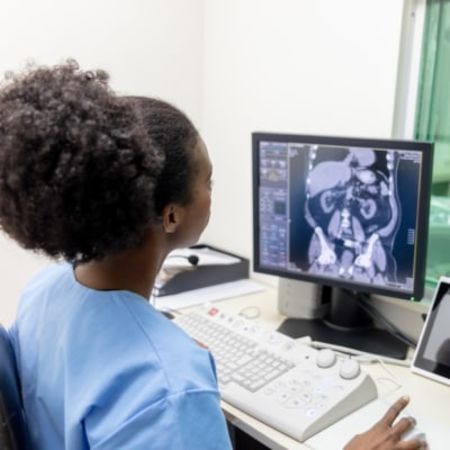Multidetector computed tomography (MDCT) accompanied by its multiple postprocessing capabilities (maximum intensity projection, multiplanar reconstruction, and volume-rendering technique) provides an alternative non-invasive imaging modality. Radiomics is a rapidly evolving field of research concerned with the extraction of quantitative metrics—the so-called radiomic features—within medical images. Today’s research session focused on radiomics application in MDCT.
A reference framework for standardisation and harmonisation of CT radiomics features: the "CadAIver" analysis
Riccardo Levi (Italy) presented his study aimed at quantifying the impact of various CT scan parameters on radiomics features (RFs) of the lumbar vertebrae using cadaveric trunks. They conducted CT scans on different scanners with varying settings and developed a normalization algorithm to standardize RFs for analysis. Results highlighted that changes in kV had the highest effect on RFs, particularly in Scanner 1, while mA variations had minimal impact. Field of view (FOV) and reconstruction kernels also significantly affected RFs. Their proposed normalization algorithm (GLM) outperformed the ComBat algorithm in standardizing RFs across different CT acquisitions. However, the study only focused on vertebral analysis, limiting its scope.
Contrast-enhanced CT-based radiomics model predicts chemotherapy efficacy in ovarian metastatic colorectal cancer patients: a preliminary study
The study from Jinghan Yu (China) assessed the effectiveness of a contrast-enhanced CT-based radiomics model in predicting outcomes for ovarian metastatic colorectal cancer (CRC) patients undergoing chemotherapy. They retrospectively analyzed 52 patients, categorizing them into chemo-benefit (C+) and no chemo-benefit (C-) groups based on treatment response criteria. Radiomics features were extracted from baseline CT images and used to develop multiple machine learning models. The support vector machine (SVM) model showed the best performance, achieving an AUC of 0.903 and high accuracy, sensitivity, and specificity. Calibration analysis and decision curve analysis (DCA) demonstrated the model's clinical utility. The study suggests that this radiomics model has potential as a non-invasive tool for predicting outcomes in ovarian metastatic CRC patients undergoing chemotherapy.
Development of a radiomic model to predict the risk of hepatocellular carcinoma in cirrhotic patients
Ludovica Leo (Italy) set out in their study to determine if radiomics could identify cirrhotic patients at risk of developing hepatocellular carcinoma (HCC). They retrospectively analysed 98 subjects, divided into two groups based on CT scans: one without evidence of HCC and the other with evidence of HCC. Radiologists manually segmented liver volumes and extracted radiomic features. Using machine learning, they identified two key features that achieved an accuracy of 0.72, sensitivity of 0.76, specificity of 0.68, precision of 0.71, and ROC-AUC of 0.78 in predicting HCC development. The radiomic model showed promising performance but lacked external validation and was more sensitive than specific.
Influence of CT scanners on radiomics features in abdominal CT: a multicentre phantom study
Markus Obmann (Switzerland) and colleagues’ goal was to assess how different CT scanners affect the stability and discriminative power of radiomics features using a 3D-printed abdominal phantom. The phantom, based on a patient's CT scan, was scanned on 13 CT scanners from 4 manufacturers with multiple repetitions. A standardized protocol was used for image acquisition and reconstruction. Analysis revealed significant differences in radiomics features among scanners and manufacturers, despite matched parameters. The study suggests that when conducting multicenter studies, considering phantom analysis and feature harmonization techniques may help select more stable radiomics features. Limitations include the limited variability of tissue types in the phantom and the inability to assess patient motion, which could further impact interscanner variations.
Radiomics and machine learning for the assessment of renal tumour histological subtypes on multiphase computed tomography: a multicentre trial with independent testing
Sophie Bachanek (Germany) presented her study focusing on how to differentiate histological subtypes of renal tumors identified on multiphase computed tomography (CT) using radiomic features and machine learning in a multicenter setting. The retrospective analysis included patients from two urological centers who underwent surgical resection and histopathological assessment of renal tumors. Preoperative CT scans from multiple imaging centers were used for radiomic feature extraction, and an extreme gradient boosting tree-based machine learning algorithm was employed for subtype prediction. The training cohort comprised 297 patients, while the testing cohort included 121 patients. The algorithm demonstrated good diagnostic performance across venous, arterial, and combined contrast phases in both the training and validation cohorts. Venous phase CT provided the most pertinent information for renal tumor subtype discrimination, and oncocytomas were the most challenging to differentiate using CT. Limitations included the heterogeneity of renal tumor subtypes and occasional low case numbers in subgroups.
Overcoming data scarcity in radiomics/radiogenomics using synthetic radiomic features
Milad Ahmadian (Netherlands) assessed in their study the effectiveness of synthetic radiomic data generation in improving the performance of radiomics/radiogenomics prediction models for colorectal cancer. They used a cohort of 386 patients with matched CT images and TP53 mutational status. Synthetic radiomic data were generated using five tabular data generation models and combined with real-world radiomic training data. Results showed that synthetic radiomic data, when combined with real radiomics, enhanced predictive model performance. However, synthetic data derived from random or noisy radiomic data did not improve performance, while true signal data effectively enhanced it. The study suggests that synthetic data augmentation could address data scarcity issues in medical AI. Limitations include the retrospective monocentric nature of the study, suggesting the need for validation on external cohorts.
Impact of population size and validation method on the performance of radiomics models: application to COVID lung lesions
Antoine Decoux (France) investigated in their study how population size and validation strategies affect the estimated performance and reproducibility of radiomics studies, using a cohort of 3,737 COVID-19 patients. Radiomics parameters were extracted from lung lesions, and various subpopulations were generated to simulate training/test populations. Prediction models were trained and validated using different strategies, including one-time split, cross-validation, and nested cross-validation. Results showed that increasing the training data size improved model performance and reduced variance, with diminishing returns observed at 400 patients. Cross-validation methods helped decrease variance and generalisation bias compared to one-time split, while nested cross-validation further reduced variance but increased generalisation bias. The study provides insights into the impact of population size and validation strategies on radiomics study outcomes, although its findings may vary depending on the clinical question and predictive power of imaging. Limitations include the use of a surrogate generalisation set rather than a true external validation set.
Image Credit: iStock



























